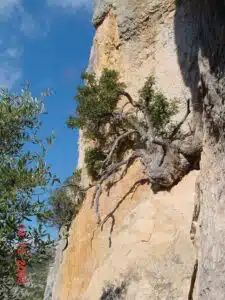The Pistacia lentiscus and its possibilities as a bonsai

Compared with other species, there is a certain lack of knowledge about the Pistacia lentiscus and its possibilities as a bonsai. The aim of this blog is to delve into its characteristics and particularities in order to learn more about the Pistacia lentiscus.
This species comes from Africa, the Near East and Mediterranean Europe, where it is as common as olive trees. It stands out for the strength of its branches and the intense green of its leaves throughout the year. That tone sets it apart from the trees that surround it in nature.
The first thing we will do is solve a doubt that many of you will already have. No, the Pistacia lentiscus does not produce pistachios, although this prized fruit does come from a tree of the same family, specifically from the Pistacia vera.
The Pistacia lentiscus’ resin is greatly appreciated. From it, mastic is made, an aromatic gum used both in dental medicine and in the production of varnishes. It is also used as a flavoring in liquors.
The Pistacia lentiscus in nature

The Pistacia lentiscus has a great capacity to develop strong roots that sink until they find moisture, which allows it to live in dry and stony terrain. Thanks to this ability, unlike other trees around it, the Pistacia lentiscus keeps its leaves green throughout the year.
The Pistacia lentiscus in bonsai
The Pistacia lentiscus are of special interest to bonsai lovers. If you learn to work its wood, which is very hard, you will know how to work most bonsai.
The Pistacia lentiscus bonsai has a very slow growth, which favors the hardness of its branches and produces dry trunks highly valued by fans. The contrast of the wood with the green of its leaves and the color of its fruits and flowers stands out.
We must bear in mind that, although it is a very resistant bonsai, it does not withstand frost well, so we must protect it from it.
Flowering and fruits of the Pistacia lentiscus

When to prune the Pistacia lentiscus bonsai
The Pistacia lentiscus bonsai pruning is done at the end of winter. Thanks to pruning, it is possible to maintain vigor in all its branches.
After pruning, few leaves should remain. After a few weeks, it will begin to regrow, while the roots grow vigorously.
The pinching of the Pistacia lentiscus

On the other hand, there are the sprouts of the more formed lentiscus. The most mature branches grow to a certain point and stop until the following season.
Wiring of the Pistacia lentiscus
In the following video you will see how to clarify, choose the floors and wire a Pistacia lentiscus prebonsai:
When do we repot a Pistacia lentiscus?
The Pistacia lentiscus is a tree that can last many years in the same pot. In the meantime, before transplanting and as maintenance, we will periodically renew the first layer of substrate, this will ensure good drainage during watering. When it is necessary to transplant, it will be the tree itself that indicates it. Its leaves will turn a dull yellow tone, which will contrast with the dark and shiny green of those that are in good condition. Another way to know it will be when, in renewing the first layer of substrate, this is full of fine roots.
The best time for transplanting is a few weeks after a good pruning, when the new sprouts begin to emerge. The growth of these shoots will also cause the growth of the roots, facilitating adaptation.
Fertilisation
The Pistacia lentiscus are grown on very hard substrates. This land at the beginning is almost sterile, so organic fertilizers will be used to activate it. A good option to fertilize the Pistacias is the Hiryo Gold organic fertiliser.
When fertilizing a Pistacia lentiscus bonsai, it will be taken into account not to facilitate the space between the sprouts. To achieve it, we will avoid favoring its growth, reducing the fertilisation in the times that it is not sprouting or sprouting less.
It will be fertilized more frequently when the sprouts have developed, usually between mid-May and June. Although during summer it will continue to sprout, during these months we will reduce the amount.
Between the end of August and October, in order to have reservations in winter, it will be fertilized abundantly, about twice a month with a large amount.
The Pistacia lentiscus bonsai greatly appreciates the contribution of iron chelate, considerably improving its cultivation. In our online store you will find the Ferrobonsai iron chelate.
Watering in the Pistacia lentiscus
The Pistacia lentiscus is a bonsai that requires frequent watering, due to its characteristics and the draining soil in which it is grown.
We hope this blog has helped you to familiarize yourself or solve your doubts about this species.
Now that you know more about the Pistacia lentiscus and its possibilities as a bonsai, will you try a Pistacia lentiscus prebonsai?
Learn more about caring for your Pistacias with the following blog about pruning cuts:
You may also be interested in…
About the Author
Mistral Bonsai
In Mistral Bonsai we are a communication team, technicians and masters committed from the first day to disseminating the wonderful art of bonsai. A world that offers many things to share. We believe that a bonsai is a tree with a soul, unique and unrepeatable. Another of our most essential pillars is, how could it be otherwise, our close commitment to the preservation of the environment and nature.
Categories
Bonsai cultivation and care (60)
Bonsai gift (2)
Bonsai pests and diseases (7)
Bonsai repotting (3)
Bonsai species (1)
bonsai substrates (2)
Bonsai summer (1)
bonsai tools (1)
Bonsai work (13)
Ceramic pots (3)
Chinese culture (2)
Chinese culture (1)
Coniferous bonsai (2)
Conifers (1)



